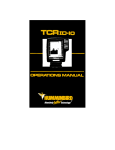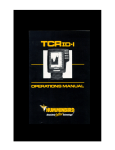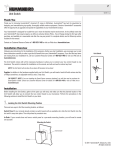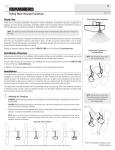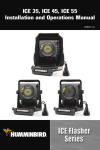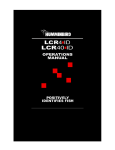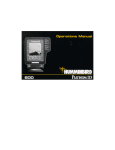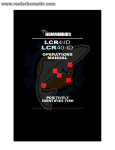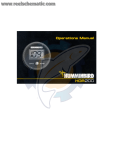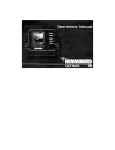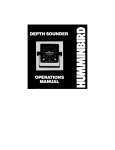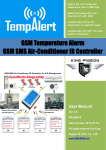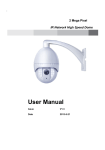Download Humminbird LCR 400 ID User's Manual
Transcript
TABLE OF CONTENTS INSTALLATION PREPARATION………………………………………………………. 2 Parts Supplied……………………………………………………………………. 2 Accessories………………………………………………………………………. 2 Installation Overview……………………………………………………………. 2 Alternative Transducers and Mounting Methods…………………………….. 4 Transducer Exchange…………………………………………………………… 5 INSTALLATION………………………………………………………………………….. Transom Installation…………………………………………………………….. Inside the Hull Installation………………………………………………………. Control Head Installation……………………………………………………….. Test the Installation……………………………………………………………… 6 6 10 12 15 BEFORE BEGINNING………………………………………………………………….. 16 USING THE LCR400ID ………………………………………………………………… Using the Built-In Simulator……………………………………………………. Front Panel Buttons…………………………………………………………….. Functions………………………………………………………………………… 18 18 19 20 SPECIFICATIONS……………………………………………………………………… 24 MAINTENANCE AND WARRANTY………………………………………………….. Maintenance…………………………………………………………………….. Troubleshooting…………………………………………………………………. Warranty…………………………………………………………………………. Service Policy…………………………………………………………………… Customer Support………………………………………………………………. 25 25 26 29 30 31 TRANSDUCER MOUNTING PROCEDURE Humminbird’s high-speed transducer is supplied with your LCR. This transducer has been designed to give good high speed readings on most all boat designs, including aluminum. Please carefully consider the following before installing your transducer. TRANSDUCER MOUNTING OPTIONS A. Transom Mount- The Humminbird high speed transducer allows the transducer element to be mounted below the bottom of the boat hull keeping the transducer out of turbulent water and insuring good high speed operation. The transducer will absorb the blow of any obstruction by rotating up out of the metal spring bracket without harming the transducer, or your boat. The transducer can be re-engaged by simply rotating the transducer down and snapping it back in place. (See Figure A) B. Inside Hull Mount- The high speed transducer can be mounted inside the hull (without pivot assembly) using the proper two-part epoxy, such as Humminbird’s epoxy kit. Even though there is some loss of signal in shooting through the hull, your LCR will perform well with this type of installation. You cannot shoot through the hull of an aluminum boat. C. Trolling motor Mount- This type of transducer is not supplied with your LCR. It is designed to mount on the foot of a trolling motor. You may exchange your un-used high speed transducer for a trolling motor transducer. Call the Humminbird Customer Service Department. D. Bronz Thru-Hull Mount- This transducer is not supplied with your LCR but for an additional cost you may exchange your un-used high speed transducer for a bronz thru-hull. The bronz thru-hull transducer has a threaded stem which installs through a hole drilled in the boat hull, leaving the housing exposed under the boat. This type of installation must be used for many boats with in-board engines, because there is no suitable location on the transom away from the noise and turbulence created by the prop. A bronz thru-hull transducer should be installed by qualified personnel only. The LCR will operate well at high speeds with a properly mounted transducer. Remember, a transducer will not work transmitting through air or through air bubbles. 1. TRANSOM MOUNTING PROCEDURE Step 1. MOUNTING LOCATION- It is important that the transducer be mounted on the transom where water flow is in constant contact with the transducer. You may wish to observe the rear of the boat while it is moving through the water to determine the best mounting location. Step 2. BRACKET INSTALLATION (Aluminum Boats)- To install the metal bracket on an aluminum boat locate the template on the transom between rows of rivets, or ribs that are on the bottom of the boat. Align the template so that the bottom corner of the template nearest the center of the transom is on the bottom edge of the transom. Once the location is determined mark and drill three 7/64” dia.. holes noted on the template. Attach the metal bracket using three #10 self threading screws supplied. Be sure to align holes in the center of the Bracket slots. On some aluminum boats it may be necessary to use a wood back-up plate. It is important to use a silicone sealant between the screwhead and bracket in order to prevent leaking. (See Figure C) Step 2. BRACKET INSTALLATION (Fiberglass Boats)- If your boat has a stepped transom located below and under the main transom, the compact transducer design allows mounting in this area. This mounting location is recommended for good reading at very high speeds. (See Figure D) To install the metal bracket on a fiberglass boat, locate the template on the transom in the same manner as for an aluminum boat. (See Figure C) NOTE: On boats with more than 15 degree deadrise angle it may be necessary to mount the transducer slightly off parallel with the water level. (See Figure E) Mark and drill the three 9/64” dia. holes as shown on the template. Attach the metal bracket using the three #10 self threading screws supplied. Be sure to align the holes so that they are centered vertically in the three slots found in the bracket. It is important to use a silicone sealant between the screwhead and bracket in order to prevent leaking. Step 3. TRANSDUCER PIVOT ASSEMBLY- Assemble the pivot to the transducer main body using the two ¼”x5/8” allen head screws, two 3/8” tooth washers and two, ¼” square nuts. Make sure the tooth washers are sandwiched between the transducer main body and the pivot. The square nuts are trapped inside the pivot and will not rotate as the allen head screws are tightened. HOWEVER, DO NOT TIGHTEN AT THIS POINT. (See Figure F) Step 4 TRANSDUCER ASSEMBLY- Insert the transducer assembly into the metal bracket from the bottom. Push up until the holes in the plastic pivot align with the uppermost holes in the bracket. Slide the O-ring on to the headed pin and insert it through the two parts. Assemble by screwing the ¼”x3/8” allen head screw into the end of the pin and tighten. (See Figure G) Step 5 ANGLE ALLIGHMENT- Set the transducer angle so that it is parallel with the bottom of the boat hull. Once proper alignment is achieved, tighten the two allen head screws using the 5/32” allen wrench provided. The screws are visible through the access holes on each side of the metal bracket. Check to make sure the transducer main body is rigidly fastened to the pivot. (See Figure H) Step 6 CHECK POSITION OF TRANSDUCER- At this point, check to see that the bottom of the transducer is a minimum of ¼” below the bottom of the transom. (However, as noted in STEP 2, the top of the transducer cannot fall below the bottom of the transom). If it is not, remove the transducer assembly from the metal bracket by removing the pin installed during STEP 3. Loosen the metal bracket mounting screws, re-position the bracket utilizing it’s slotted holes, tighten and re-assemble. It may be necessary to replace the silicone sealant after this adjustment is made. NOTE: It may be necessary to make several high speed runs to adjust transducer either UP/DOWN or to re-adjust the angle to achieve optimum results. Step 7 CABLE CLAMPS- Install cable clamps as necessary by drilling a 1/8” dia. hole for the # 8 screw supplied. 2. INSIDE HULL MOUNTING PROCEDURE Warning: In order to achieve proper results with this type installation, it is important that the transducer be mounted by someone familiar with the use of two part epoxy adhesives. For this reason, Techsonic Industries, Inc. will not be responsible for any damage due to the mounting of your transducer in this manner. NOTE: An Epoxy Kit (Part N. EPK) is available from Humminbird. This Epoxy Kit has been formulated for Inside Hull Transducer Installation. 1. Select as flat an area as possible near the aft end and center of boat where the hull is thin and not double. If the bottom has a runner down the center of boat, select an area to one side of the runner, but as close to the runner as possible. 2. Clean the inside of the boat with lacquer thinner in the area transducer is to be mounted. Outside of boat in this area should also be cleaned. (Not with lacquer thinner). 3. Put approximately one inch of water in the bottom of the boat. 4. Put transducer in the water. The bottom of the transducer should be in a flat area and should be in good contact with the bottom of the boat. 5. Operate the LCR with the boat operating at high speed. The transducer may have to be moved in order to find an area where satisfactory operation is observed. 6. When an area is found that produces satisfactory operation, mark the location of the transducer. 7. Remove the water and transducer and clean the marked area and the bottom of the transducer thoroughly. 8. Using the Humminbird Epoxy Kit or equivalent, mix an ample amount of epoxy without causing it to bubble and pour it in the area the transducer is to be mounted. The puddle should be larger than the bottom of the transducer. 9. Coat the bottom of the transducer with epoxy, then put it in the center of the puddle and push down on the transducer while moving it around in a circular motion. This forces out any air bubbles that may be trapped between the bottom of the transducer and the hull of the boat. 10. Let epoxy cure then the transducer is ready to operate. No water is now required in the bottom of the boat and gas and oil that is spilled inside of the boat will not degrade performance as it will if the transducer is placed only in water. CAUTION: Do not use the silicone seal or any soft adhesive to bond the transducer to the hull. This will reduce the sensitivity of the unit. CAUTIONS 1. Occasionally the “eye“ of your transducer may become dirty from storage or from contact with oils present in boats or marina environments. (Oil will cause the “eye” to lose the intimate contact with the water which is necessary for efficient operation.) The “eye” may be cleaned with liquid detergent. 2. Improper installation of the transducer can alter the efficiency and accuracy of the entire system. 3. If your boat of transducer is out of the water for a period of time, it may take a short period of time for the transducer to become thoroughly “wetted” when returned to the water. Also, re-entry may cause turbulence, which will create air bubbles in the “eye” of the transducer. The bubbles will disappear in a short time or can be removed by rubbing the transducer “eye” with your fingers while the transducer is in the water. 4. If your instrument should fail to function, be sure to check all the electrical connections before removing the transducer or calling a serviceman. 5. Inspect your transducer cable and make sure that it has not been cut or damaged to the point where it will affect the performance of the transducer. A slight nick or cut, exposing the outer cable, can be repaired by wrapping with electrical tape. A transducer can be damaged if the inner cable and outer cable are allowed to make contact. Such a problem can sometimes be corrected by properly splicing the coaxial cable. This should only be attempted by a qualified service technician. 6. If your LCR is not working properly and you suspect the problem might be in your transducer, we would recommend you borrow a unit from a friend and try it on your boat. If the symptoms are the same, you can almost be certain that the problem is in the transducer. INSTALLING THE LCR The LCR should be mounted on a flat, solid surface for maximum stability. The low profile swivel mount has four holes drilled in the base. It is recommended that all four holes be used. Position the swivel base and drill four ¼” diameter holes. Note: The LCR hole pattern Is the same as for all Humminbird flasher units. Use hardware provided to mount this base to the boat. Next place the gimbal bracket on the swivel base and attach with four small machine screws, provided. Place the LCR in the gimbal mount and make certain the rubber washers provided are placed between the unit and the gimbal bracket Important: Note which side of the gimbal faces forward. (Slots on gimbal bracket go towards rear). Also, rubber washer must be located between the unit and the gimbal bracket. Install the mounting knobs and tighten snugly. The unit can now be swiveled and tilted to any desired position. OTHER MOUNTING OPTIONS 1. The LCR gimbal bracket can also be mounted on the SM-4, quick disconnect swivel mount. 2. The LCR gimbal bracket can also be mounted directly to the dash without the swivel mount, however, this method is not recommended since the unit cannot be rotated. INSTALLING THE CABLES Your LCR comes equipped with Humminbird’s new Angle-Lock power and transducer connectors. The power connector is identified with the letter P on the back of the plug. It plugs into the outlet on the back of the unit marked “Power”. The transducer connector is identified with the letter T and plugs into the outlet on the back of the unit marked “Transducer”. Note: An adapter (AD-4) is available to allow use of an old waterproof (BNC) transducer with the LCR, but be sure that the transducer is a 16degree. A 32degree transducer cannot be used. A 11/8” hole must be drilled to pull through the transducer connector. After drilling the hole, pull the transducer connector up through the hole. If you are installing two units, both transducer connectors can be pulled through this 1 1/8” inch hole. Next, push the power cable wires down through the hole. A hole cover has been provided which will dress and hold the wires. Install the hole cover after determining the necessary wire length from the hole. The power cable has a red lead to the positive (+) post and the black lead to the negative (-) post. Install a 1 amp fuse between the red cable and positive post of your 12-volt battery. If a fuse panel is available, we recommend wiring the power cable into the fuse panel. Note: The LCR must be fused separately from any other accessory. Your Angle-Lock connectors can only be plugged in one way. Position the connector so the letter P or T can be read and the 90 degree bend is pointed downward. Push the connector in as far as it will go. Turn the positive locking ring as far as it will go clockwise until you feel it lock. Locking ring as far as it will go clockwise until you feel it lock. Your connector is now locked into place. Note: For easy access to the connectors, simply loosen the mounting knobs and tilt your LCR forward. The connectors are now in full view and easy to plug or unplug. BEFORE BEGINNING HOW THE LCR400ID WORKS HOW THE LCR400ID WORKS There are two main components to an LCR400ID installation: The transducer, which you will install on the transom or inside the hull, and the LCR 400ID unit which you will mount with the supplied gimbal bracket. The transducer and LCR 400ID communicate by means of a cable, and are powered by your boat’s 12-volt DC battery. The transducer and LCR 400ID use the basic principles of sonar to reveal objects beneath the water's surface. The LCR 400ID continuously sends electronic signals to the transducer, which converts them to ultrasonic signals that it aims toward the bottom. Each signal travels downward until it strikes an object or the bottom, then immediately echoes back to the transducer. As the transducer receives these signals, it converts them back to electronic signals for display on the LCR400ID screen. The LCR 400ID uses the returned signals to display a detailed underwater image, and constantly updates the display as you travel across the water. The display informs you of the current depth and reveals individual fish, schools of fish, their location, and bottom details. Easy-to-use controls on the LCR 400ID allow you to set the depth range, adjust display speed and sensitivity, enable a fish alarm and bottom alarm, and display a "zoom" window of still more detailed information. BEFORE BEGINNING THE HUMMINBIRD ADVANTAGE THE HUMMINBIRD ADVANTAGE The LCR 400ID incorporates the best of available technologies, and offers advantages you won’t find in other depth sounders. The liquid crystal display (LCD) offers sharp viewing even in bright, direct sunlight, and is continuously lit for nighttime operation. Advanced LCD “super-twist” technology built into the LCR 400ID offers a wider viewing angle and higher contrast than ordinary LCD screens. (You will notice that the display can be seen better at certain angles. The gimbal mounting bracket lets you easily adjust the viewing angle for optimum viewing. Note also that some polarized glasses can affect your viewing by causing a rainbow or prism to appear; if so, tilt the unit slightly.) Though it includes sophisticated electronics, the LCR 400ID is tough enough to take the pounding punishment of rough seas or a race across the lake. Completely waterproof – even saltwater-proof – your LCR 400ID will provide you with many years of thoroughly reliable operation. In the unlikely event that your Humminbird does require repairs, we offer an exclusive Service Guarantee – free of charge during the first year after purchase, and available at a reasonable rate after the one-year warranty period. Complete details are included in this manual. USING THE LCR400ID USING THE BUILT-IN SIMULATOR USING THE LCR400ID This section provides complete information on operating the LCR 400ID through its front panel controls. You are encouraged to read this information completely as you first learn to use the LCR 400ID. Doing so will ensure you make the most of its many features and functions. The first part of this section explains the use of the built-in practice simulator, which you can use to practice selecting functions through the front panel. The remaining instructions, which can be followed while using the simulator or in actual operation, explain each function and are organized according to the front panel layout. USING THE BUILT-IN SIMULATOR The LCR 400ID includes a built-in simulator that helps you learn to use your new equipment. The simulator displays a typical underwater scene, and lets you practice with the controls. The unit must be turned off before you start the simulator. To activate it, press down and hold the POWER button until a chirping sound begins. Release the button, and the built-in simulator begins displaying a typical LCR 400ID reading. You can use the simulator to learn the functions explained in the following pages, just as if you were getting actual on-the-water readings (but note that “Sensitivity” is disabled). To turn off the simulator, turn off the unit by pressing the POWER button again. Of course, the best way to learn the LCR 400ID is with actual use, especially in familiar waters. If you know what’s below and see it on-screen, you’ll quickly become an LCR 400ID expert. USING THE LCR400ID OPERATING THE LCR400ID FRONT PANEL BUTTONS The LCR 400ID offers several functions that you can adjust with the front panel buttons. (Note that to select something with a button, you must press it fully so that you hear a “chirp” sound). You can get acquainted with these features by actual operation, or when using the simulator. POWER: Press this once to turn the LCR 400ID on. Pressing it again turns the LCR 400ID off. (Any adjustments you make with the other front panel buttons are retained, as long as the 12-volt DC power supply remains connected). When the unit is off, keeping POWER pressed for about 2 seconds starts the built-in simulator. STOP: Press this to “freeze” the display so you can study it. Press it again to restart the display movement. SELECT: This button is used to access the following functions for further adjustments: • • • • • • • • Sensitivity/Units Bottom Alarm Fish Alarm Zoom Bottom Lock Display Speed Depth Range Fish ID To adjust any of these, press SELECT until the function you want appears. Each function’s display tells you how to use the arrow buttons and ON/OFF for adjustment; when first learning, you should also refer to the following instructions. After you adjust any function, the display returns to its full-screen reading. NOTE: The last function you select remains “active” – that is, you can adjust it without having to press SELECT again. You can use this to simplify operations. For example, if the bottom alarm is the last function used, you can readjust the alarm by pressing one of the arrow buttons. Or, if you often use Zoom, you can select it once, then switch it on and off by simply pressing ON-OFF. The following sections describe each function, in order os appearance as you first press SELECT. USING THE LCR400ID OPERATING THE LCR400ID SENSITIVITY 1. Selecting Sensitivity/Units; Factory setting: +0/FEET The Sensitivity/Units function has two uses: It lets you adjust LCR 400ID sensitivity and controls whether depth measurement is in feet or fathoms. The LCR 400ID automatically increases or decreases its sensitivity setting when water conditions change (as when the bottom is stirred up). If you want to manually adjust Sensitivity, select SENS and press the Up or Down arrow button to adjust the automatic setting with a “+5” to “-5” range. For example, if you set it at “+2”, Sensitivity remains 2 settings higher than the normal automatic setting. Pressing the ON-OFF button when the SENS menu is displayed switches the unit of depth measurement between feet and fathoms. BOTTOM ALARM 2. Enabling Bottom Alarm; Factory Setting: OFF The Bottom Alarm lets you specify the minimum depth you want to maintain. To use it, select B ALM; then press the ON-OFF button to activate the alarm, and the Up or Down arrow key to adjust the depth at which the alarm will sound. An alarm symbol is displayed when this function is on. When Bottom Alarm is on, you’ll hear a continuous chirping sound when the bottom is shallower than you defined. This is very handy for alerting you to shallow water or helping you to maintain position over structure. USING THE LCR400ID OPERATING THE LCR400ID FISH ALARM 3. Enabling Fish Alarm; Factory Setting: OFF The Fish Alarm alerts you with a chirping sound whenever the LCR 400ID detects fish (or another object not attached to the bottom). To activate it, select FISH ALM and press the ON-OFF button. A fish symbol reminds you that the alarm is on. ZOOM 4. Using Zoom; Factory Setting: OFF Zoom provides an up-close view. To activate it, select Zoom and press ON-OFF. The Zoom view initially begins at the surface; pressing the Up or Down arrow adjust the Zoom depth. The range of the display is shown when the Zoom is on. The Zoom range depends on the current Depth Range: 7 ½’ in the 15’ and 30’ Depth Ranges, 15’ in the 60’ and 120’ Depth Ranges, and 30’ in the 180’ to 600’ Depth Ranges. Remember: If Zoom is the last function selected, you can use the arrow button to adjust the Zoom depth or ON-OFF to switch Zoom on and off without having to press SELECT first. USING THE LCR400ID OPERATING THE LCR400ID BOTTOM LOCK 5. Using Bottom-Lock; Factory Setting: OFF Bottom-lock provides an up-close view like Zoom, except that in this case the zoomed view automatically moves up or down to stay on the bottom. To use this feature, select BTM LOCK and press ON-OFF. The range of the display is shown when Bottom-Lock is on. This is an ideal feature for finding structure or Iocating fish near the bottom. Remember: If Bottom-Lock is the last function selected, you can use the ON-OFF button to switch Bottom-Lock on and off without having to press SELECT first. DISPLAY SPEED 6. Setting Display Speed; Factory Setting: One level below maximum The LCR 400ID display is “updated” (advances across the screen) as you move through the water. The speed at which the display is updated depends on the Display Speed setting. To adjust it, select SPEED, and press the Up arrow for a faster setting or the Down arrow for a slower setting. In general, higher Display Speed settings provide faster updates, while slower Display Speeds provide more detailed information. USING THE LCR400ID OPERATING THE LCR400ID DEPTH RANGE 7. Setting Depth Range; Factory Setting: On (Automatic) When you turn the LCR 400ID on, it finds the bottom, sets the ideal depth range, and automatically adjusts the depth range (to as much as 480’) as the depth changes. In this “Auto Depth Range” mode, the bottom is blacked-in for easy-to-understand readings. If you prefer, you can turn Auto Depth Range off. Select RANGE, press ON-OFF, and adjust the Depth Range with the Up or Down arrow key. You can set the Depth Range up to 600’. In this “Manual Depth Range” mode, the bottom is not blacked in. This lets you see a “second return,” which is preferred by some fishermen because the width of the second echo can indicate bottom hardness. FISH ID 8. Selecting Fish ID; Factory Setting: On (Automatic) When you turn the LCR 400ID on, the unit automatically sets Fish ID to the On position. To turn the ID feature off, and display fish with pixels instead of the ID icons, press the ON-OFF button while within the Fish ID menu. Pressing the ON-OFF button again reactivates the ID function. SPECIFICATIONS Operating Frequency 200 KHz Power Requirements 10-16 Volts Power Cable Length Standard Unit 48” Portable Unit Non-replaceable Transducer: Standard XHS-6-16 Portable XPT-6-16 Transducer Cone Angle 16 degrees Depth Ranges 0 to 15’, 30’, 60’, 120’, 180’, 240’, 360’, or 480’ (plus 0600’ in manual mode) Zoom Ranges 7½’, 15’, 30’ Unit Construction High-impact Polycarbonate housing Unit Dimensions 6”W X 4¾”H X 2”D Display Super-twist liquid crystal Viewing Area 2 7/16” W X 2 5/8” H Matrix Configuration 32 X 46 pixels MAINTENANCE AND WARRANTY MAINTENANCE MAINTENANCE Your Humminbird fishfinder is designed to provide years of trouble free operation with virtually no maintenance. Follow these simple procedures to ensure your Humminbird continues to deliver top performance. • If the unit comes into contact with salt spray simply wipe the affected surfaces with a cloth dampened in fresh water. Do not use a chemical glass cleaner on the lens. Chemicals in the solution may cause cracking in the lens of the unit. • When cleaning the LCD protective lens, use a chamois and non-abrasive, mild cleaner. Do not wipe while dirt or grease is on the lens. Be careful to avoid scratching the lens. • If your boat remains in the water for long periods of time, algae and other marine growth can reduce the effectiveness of the transducer. Periodically clean the face of the transducer with liquid detergent. Pivoting the transducer up in the bracket may allow better access for inspection or cleaning. • If your boat remains out of the water for a long period of time, it may take some time to wet the transducer when returned to the water. Small air bubbles can climb to the surface of the transducer and interfere with proper operation. These bubbles dissipate with time, or you can wipe the face of the transducer with your fingers after the transducer is in the water. • Never leave the fishfinder in a closed car or trunk - the extremely high temperatures generated in hot weather can damage the electronics. MAINTENANCE AND WARRANTY TROUBLESHOOTING TROUBLESHOOTING Do not attempt to repair the fishfinder yourself. There are no user serviceable parts inside, and special tools and techniques are required for reassembly to ensure the waterproof integrity of the housing. Repairs should be performed only by authorized Humminbird technicians. Many requests for repair received by Humminbird involve units that do not actually reed repair. These units are returned “no problem found.” If you have a problem with your Humminbird, use the following troubleshooting guide before calling Customer Support or sending your unit in for repair. Your Humminbird fishfinder contains several tools that can aid in determining if there is a problem and how to isolate and repair the problem in many cases. 1. Nothing happens when I turn the unit on. Check the power cable connection at both ends. Be sure the cable is connected correctly to a reliable power source - red lead to positive, black lead to negative or ground. Ensure the power available at the mount is between 10 and 20 VDC. If the unit is wired through a fuse panel, ensure the panel is powered. Often accessory fuse panels are controlled by a separate switch or the ignition switch. Also, often a fuse can appear to be good when in fact it is not. Check the fuse with a tester or replace it with a fuse known to be good. Check the power connection to the unit. It is possible to force the power cable connector into the cable holder incorrectly. If the connector is reversed, the unit will not work. Examine the contacts on the back of the unit to ensure there is no corrosion. Finally, ensure the unit is firmly seated on the mount. The electrical contacts are not made until the unit is fully seated. Ensure the metal cable retainer is properly installed in the mount. If not, the power connected may push out when the unit is put on the mount. 2. There is no transducer detected. Most Humminbird fishfinders have the ability to detect and identify that a transducer is connected. If at power up, a message indicates "transducer not connected,” only simulator operation is possible. First, ensure that an appropriate transducer connector is positioned correctly in the connector holder, and that the unit is fully seated on the mount. Your Humminbird fishfinder will work only with an appropriate transducer; check the accessory guide for compatibility. MAINTENANCE AND WARRANTY TROUBLESHOOTING Second, inspect the transducer cable from end to end for breaks, kinks, or cuts in the outer casing of the cable. Also ensure the transducer is fully submerged in water. If the transducer is connected to the unit through a switch, temporarily connect it directly to the unit and try again. If none of these items identifies an obvious problem, the transducer itself is probably the problem. Be sure to include the transducer if returning the unit for repair. 3. There is no bottom reading visible on the display. There are a number of possible causes for this condition. If the loss of bottom information occurs only at high boat speeds, the transducer needs adjusting. If the digital depth readout is working but there is no bottom visible on-screen, it is possible the depth range has been adjusted manually to a range lower than what is needed to display the bottom. Also, in very deep water, it may be necessary to manually increase the sensitivity setting to maintain a graphic depiction of the bottom. If you are using a transducer switch to connect two transducers to the unit, ensure the switch is in the correct position to connect a transducer that is in water. (If a trolling motor transducer is selected and the trolling motor is out of water, no sonar information appears.) It none of the above solve the problem, inspect the transducer cable from end to end for breaks, kinks, or cuts in the outer casing of the cable. If the transducer is connected to the unit through a switch, temporarily connect it directly to the unit and try again. If none of these items identifies an obvious problem, the transducer itself may be the problem. Be sure to include the transducer if returning the unit for repair. 4. When in very shallow water, I get gaps in the bottom reading and inconsistent digital depth indication. Your Humminbird fishfinder will work reliably in water 2’ (.6m) or deeper. The depth is measured from the transducer, not necessarily from the surface. MAINTENANCE AND WARRANTY TROUBLESHOOTING 5. The unit comes on before I press POWER, and won't turn off. Check the transducer cable. If the outer jacket of the cable has been cut and the cable is in contact with bare metal, you need to repair the cut with electrical tape. If there is no problem with the cable, disconnect the transducer from the unit and see if the problem is corrected, to confirm the source of the problem. 6. I get gaps in the reading at high speeds. Your transducer needs adjusting. If the transducer is transom-mounted, there are two adjustments available to you - height and running angle. Make small adjustments and run the boat at high speeds to determine the effect. It may take several tries to optimize high speed operation. This can also be a result of air or turbulence in the transducer location caused by rivets, ribs, etc. 7. My unit loses power at high speeds. Most Humminbird fishfinders have over-voltage protection that turns the unit off when input voltage exceeds 20 VDC. Some outboard motors do not effectively regulate the power output of the engine's alternator and can produce voltage in excess of 20 volts when running at high RPMs. Your fishfinder displays input voltage in the Diagnostic screen. Use this readout to determine if the voltage exceeds 20 VDC. 8. The screen begins to fadeout. Images are not as sharp as normal. Check the input voltage using Diagnostic. The fishfinder will not operate on input voltages below 10 VDC. 9. The display shows many black dots at high speeds and high sensitivity settings. You are seeing noise or interference caused by one of several sources. Noise can be caused by other electronic devices. Turn off any nearby electronics and see if the problem goes away. Noise can also be caused by the engine. If engine noise is causing the interference, the problem will intensify at higher RPMs. Increase the engine speed with the boat stationary to isolate this cause. Propeller cavitation can appear as noise on-screen. If the transducer is mounted too close to the propeller, the turbulence generated can interfere with the sonar signal. Ensure that the transducer is mounted at least 15" (38cm) from the prop. MAINTENANCE AND WARRANTY WARRANTY HUMMINBIRD ONE YEAR FULL WARRANTY First year repairs (from original date of purchase) on your Humminbird fishfinder are absolutely free. This does not include physical damage to the unit or its accessory items. Any modification or attempt to repair the original equipment or accessories by unauthorized individuals will void the warranty. Return the warranty registration card and retain your bill of sale for warranty verification. Accessories not manufactured under the Humminbird trade name are not covered by our warranty. The customer is responsible for shipping charges to Humminbird. Humminbird will provide ground UPS or Parcel Post shipping back to the customer free of charge. This warranty applies to the original purchaser only. This warranty is in lieu of all other warranties expressed or implied and no representatives or persons are authorized to provide for any other liability in connection with the sale of our products. Humminbird reserves the right to perform modifications or improvement on its products without incurring the obligation to install the changes on units previously manufactured, sold, delivered, or serviced. THIS IS A FULL WARRANTY AS DEFINED BY THE FEDERAL WARRANTY ACT EFFECTIVE JULY 4 1975. MAINTENANCE AND WARRANTY SERVICE POLICY SERVICE POLICY This Service Policy is valid in the United States only. This applies to Humminbird units returned to our factory in Eufaula, Alabama, and is subject to change without notice. All repair work is performed by factory-trained technicians to meet exacting factory specifications. Factory serviced units go through the same rigorous testing and quality control inspection as new production units. Even though you'll probably never need to take advantage of our incredible service guarantee, it’s good to know that we back our unit this well. We do it because you deserve the best. We will make every effort to repair your unit within three working days from the receipt of your unit. This does not include shipping time to and from our factory. Units received on Friday are usually shipped by Wednesday, units received Monday are usually shipped by Thursday, etc. We reserve the right to deem any product unserviceable when replacement parts are no longer reasonably available or impossible to obtain. After the original warranty period, a standard flat rate service charge will be assessed for each repair (physical damage and missing parts are not included). Please call our Customer Support Department to verify the service charge for your unit. The standard service charge includes UPS or Parcel Post freight only. If charges are not prepaid, the unit will be returned COD. If you are experiencing problems related to bottom or depth readings please send your transducer along with your unit when sending for repair. MAINTENANCE AND WARRANTY CUSTOMER SUPPORT CUSTOMER SUPPORT If you have any questions, call our Humminbird Customer Support Hotline: 1-334-687-0503 Throughout the U.S. and Canada, hours are Monday-Friday, 8:00 a.m. to 5:00 p.m. Central time. If after reading “Troubleshooting” you determine your unit needs factory service, please attach a description of the problem and send it with the unit to the address below. If you are including a check please attach it to the unit. Humminbird Service Department Three Humminbird Lane Eufaula, AL 36027 USA




























